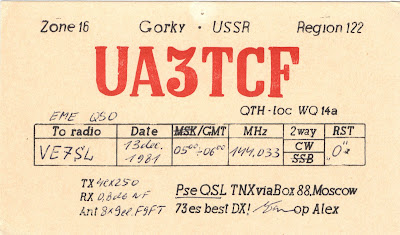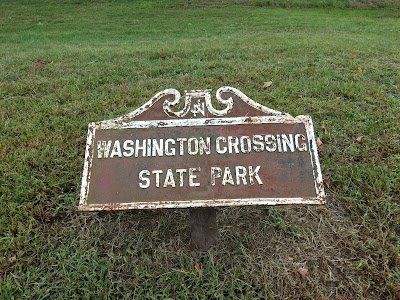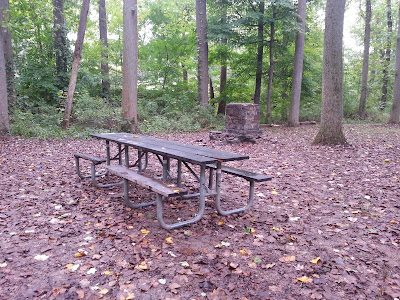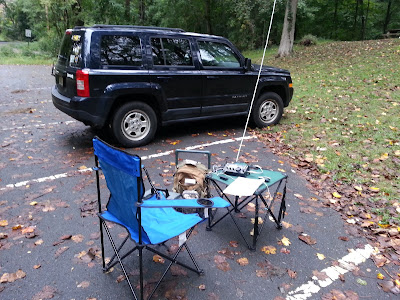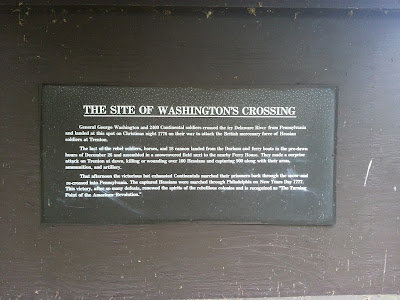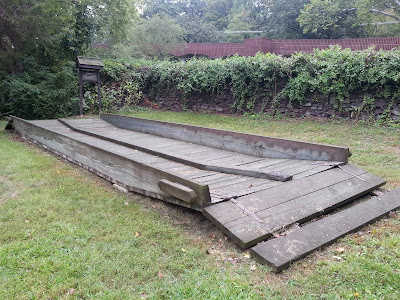Archive for the ‘antennas’ Category
 The JK BevFlex-4 Antenna
The JK BevFlex-4 Antenna

This past week, comments regarding an interesting new low-noise directionally-switched receive antenna popped-up on both the Topband reflector and the IRCA (BCB DXers) reflector.
The new JK BevFlex-4 is reported to work very well without requiring a lot of real estate for deployment. The antenna was designed by Geoff Mendenhall, W8GNM, and Ned Mountain, WC4X.
There are several things that make this package a little different. The antenna can be configured in four basic forms: CLASSIC BEVERAGE, BEVERAGE ON GROUND (BOG) / BEVERAGE IN SOD (BIS), INVERTED EWE, or as a FLAG. What is quite different however is its flexible feedpoint allowing the antenna to be fed at any point along its length when used in the BOG or BEVERAGE configuration. The antenna is completely passive and requires no preamplification although, in some configurations, it is suggested for use above 7MHz.
Full details can be found at the JK Antennas website, as well as the manual and a FAQ page.
The FAQ sheet indicates that it will perform from LW through to 10m but the most dramatic improvement in reception from users has been noted on the lower bands. It sounds like it might make an interesting antenna for NDB DXing as well.
In the BOG form, the antenna can lay right on the ground or be buried (BIS) just below the surface using RG-6 for the actual antenna element. Other configurations allow much smaller, stealth-sized wire to be employed.
An interesting YouTube video of the antenna in action as well as an in-depth description may be viewed here:
Here is one comment from an east coast topbander:
I also bought one this year....deployed it as an EWE, as that’s all the room
I have, small lot in a subdivision.....in order to work them you need to
hear them, and once I put that up, I could hear !!! first put up as EU/VK-ZL
and worked several in the DX contest, but when the african dxpedetions were on, moved it to due east/west., and worked all of them, S01, etc.....front to back is remarkable on 160, it works ok on 80, (mine was 10ft high and 38 ft long) but really rocks on 160 !!!!, and really cuts down the line noise/static I normally hear on my transmit Inv L.
Perhaps this may be your answer for a small effective receive antenna for LW and above but even if not, their website description makes for interesting reading.
 The JK BevFlex-4 Antenna
The JK BevFlex-4 Antenna

This past week, comments regarding an interesting new low-noise directionally-switched receive antenna popped-up on both the Topband reflector and the IRCA (BCB DXers) reflector.
The new JK BevFlex-4 is reported to work very well without requiring a lot of real estate for deployment. The antenna was designed by Geoff Mendenhall, W8GNM, and Ned Mountain, WC4X.
There are several things that make this package a little different. The antenna can be configured in four basic forms: CLASSIC BEVERAGE, BEVERAGE ON GROUND (BOG) / BEVERAGE IN SOD (BIS), INVERTED EWE, or as a FLAG. What is quite different however is its flexible feedpoint allowing the antenna to be fed at any point along its length when used in the BOG or BEVERAGE configuration. The antenna is completely passive and requires no preamplification although, in some configurations, it is suggested for use above 7MHz.
Full details can be found at the JK Antennas website, as well as the manual and a FAQ page.
The FAQ sheet indicates that it will perform from LW through to 10m but the most dramatic improvement in reception from users has been noted on the lower bands. It sounds like it might make an interesting antenna for NDB DXing as well.
In the BOG form, the antenna can lay right on the ground or be buried (BIS) just below the surface using RG-6 for the actual antenna element. Other configurations allow much smaller, stealth-sized wire to be employed.
An interesting YouTube video of the antenna in action as well as an in-depth description may be viewed here:
Here is one comment from an east coast topbander:
I also bought one this year....deployed it as an EWE, as that’s all the room
I have, small lot in a subdivision.....in order to work them you need to
hear them, and once I put that up, I could hear !!! first put up as EU/VK-ZL
and worked several in the DX contest, but when the african dxpedetions were on, moved it to due east/west., and worked all of them, S01, etc.....front to back is remarkable on 160, it works ok on 80, (mine was 10ft high and 38 ft long) but really rocks on 160 !!!!, and really cuts down the line noise/static I normally hear on my transmit Inv L.
Perhaps this may be your answer for a small effective receive antenna for LW and above but even if not, their website description makes for interesting reading.
 EME In The ’80s
EME In The ’80s
 |
| VE7SL - my original 2m EME antenna. |
Unlike today's widespread JT65B usage on eme, where signals can be many db into the noise and inaudible by ear, eme contacts could only be completed by actually copying signals that you could hear with your ears. This usually required big antennas and lots of power.
After a year and a half of evening work in my basement shop, my system was pretty much ready to go. I built a kilowatt amplifier, from the ARRL's VHF Handbook, along with its plate and screen power supplies.
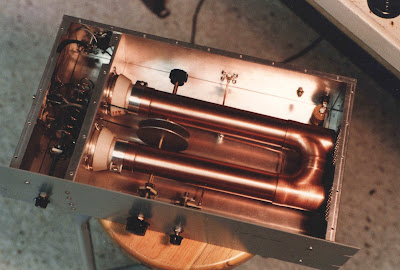 |
| 2m 'Plumbers Delight' handbook amp. |
My antennas (see above), as well as the large H-frame support, were also built in the basement and used all scrap aluminum from one of the numerous scrap yards that were in Vancouver at the time. The system consisted of sixteen separate 6 element NBS-styled yagis, all phased. Many of the two-dozen plus N connectors were bought at Boeing Surplus near Seattle, another interesting source of parts, also now long gone. Keeping water out of the phasing lines and connectors was a real challenge here in the rain forest and if one connector was not done exactly right, would create a lot of headaches.
The antenna took up a large portion of my small, 33'-wide suburban backyard. Pointing was all done by hand, using homemade scales to indicate elevation and azimuth angles, so that it could be pointed accurately even on cloud covered days and nights. A hand-cranked boat winch took care of elevation. I had a switch-box full of surplus VHF relays out at the antenna that protected my JFET preamp and also allowed me to compare sky and sun noise against a 50 ohm load.
Over the course of a few years, the system was employed to work many Europeans as well as North American VEs' and Ws'. The one contact that stands out memorable for me, was with UA3TCF, east of Moscow. This was because I had to aim the array directly into my two-story house, located about 20' away! The moon was very low as well, so that not much elevation was required.
I eventually found that trying to hold down a full-time high school teaching job and running sked requests at 0300 were not very compatible! It also became a lot of work just to maintain the system properly. I had met and completed my original goals and it became time to move on.
Eventually the array was broken down into smaller sections and sold to local 2m guys, along with the amplifier ... but it was a huge learning experience for me and the fact that I survived building and playing with a 2,000 volt power supply, still scares the heck out of me!
 |
| Plate & screen supply for the 2m amp. |
 |
| The VHF rack with xvrtrs and amps 50mHz-432mHz. |
 |
| My gal Sal adorning the 2m tower on a snowy Sunday morning. |
 EME In The ’80s
EME In The ’80s
 |
| VE7SL - my original 2m EME antenna. |
Unlike today's widespread JT65B usage on eme, where signals can be many db into the noise and inaudible by ear, eme contacts could only be completed by actually copying signals that you could hear with your ears. This usually required big antennas and lots of power.
After a year and a half of evening work in my basement shop, my system was pretty much ready to go. I built a kilowatt amplifier, from the ARRL's VHF Handbook, along with its plate and screen power supplies.
 |
| 2m 'Plumbers Delight' handbook amp. |
My antennas (see above), as well as the large H-frame support, were also built in the basement and used all scrap aluminum from one of the numerous scrap yards that were in Vancouver at the time. The system consisted of sixteen separate 6 element NBS-styled yagis, all phased. Many of the two-dozen plus N connectors were bought at Boeing Surplus near Seattle, another interesting source of parts, also now long gone. Keeping water out of the phasing lines and connectors was a real challenge here in the rain forest and if one connector was not done exactly right, would create a lot of headaches.
The antenna took up a large portion of my small, 33'-wide suburban backyard. Pointing was all done by hand, using homemade scales to indicate elevation and azimuth angles, so that it could be pointed accurately even on cloud covered days and nights. A hand-cranked boat winch took care of elevation. I had a switch-box full of surplus VHF relays out at the antenna that protected my JFET preamp and also allowed me to compare sky and sun noise against a 50 ohm load.
Over the course of a few years, the system was employed to work many Europeans as well as North American VEs' and Ws'. The one contact that stands out memorable for me, was with UA3TCF, east of Moscow. This was because I had to aim the array directly into my two-story house, located about 20' away! The moon was very low as well, so that not much elevation was required.
I eventually found that trying to hold down a full-time high school teaching job and running sked requests at 0300 were not very compatible! It also became a lot of work just to maintain the system properly. I had met and completed my original goals and it became time to move on.
Eventually the array was broken down into smaller sections and sold to local 2m guys, along with the amplifier ... but it was a huge learning experience for me and the fact that I survived building and playing with a 2,000 volt power supply, still scares the heck out of me!
 |
| Plate & screen supply for the 2m amp. |
 |
| The VHF rack with xvrtrs and amps 50mHz-432mHz. |
 |
| My gal Sal adorning the 2m tower on a snowy Sunday morning. |
 More On The PAØRDT E-Probe
More On The PAØRDT E-Probe
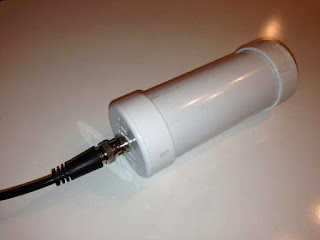 |
| Courtesy: http://www.leeszuba.com/projects/ |
Another recent reflector question about noise mitigation for active e-probe antennas brought further incite from Roelof Bakker, PAØRDT.
I found particular interest in his method of determining if the noise is being picked up by the antenna or being introduced by the feedline. As well, Roelof suggests one of the most important aspects of homebrewing ... keeping detailed notes of all tests or changes. He also suggests maintaining a healthy outlook regarding noise and rather than getting discouraged, take on the challenge of overcoming it!
Hello all,
I have been dealing with this subject for more then 10 years now and
I am pleased to pass on what I did learn so far.
The first item to look at is noise pick up on the feed line. This
can be a coax cable or a CAT5/6/7 network cable. Looking for noise
pick up on the feed line should be done without the active antenna
connected. Otherwise everything should be the same as when using the
antenna.
Ideally the antenna should be replaced by a 50 ohm termination that
can handle the power that is supplied by the DC-power supply feeding
the antenna. However, this is not necessary to achieve good results.
I am fortunate to own a PERSEUS SDR, that besides an excellent
receiver is also a nice piece of test gear. For noise pick-up
measurements I use HF-Span that changes the PERSEUS into a 0-40 MHz
spectrum analyser with a noise floor of -112 dBm. For narrow band
measurements the PERSEUS is used with Linrad, which can provide
accurate results.
Whilst looking at noise pick-up on the cable, one can unplug all
suspect devices and check if the noise is still present.
The most effective measure is grounding the shield of the coax cable
at the bottom of the mast, but I had still noise ingress of about -
100 dBm around 15 MHz. This could be solved by moving the power
supply and interface of the antenna from the operating position to
the location of the cable entry to the house. This minimises the
length of cable inside the house before the a rf-isolating
transformer used in the interface.
It is mandatory to use a separate radio earth, isolated from the
mains earth. My PC is connected to a mains outlet with a mains earth
connection, but no other equipment in the shack is using the mains
earth. This works for me.
There is also a discussion about the use of a common mode choke
versus a rf-isolating transformer. I have tried both and they both
work. However a rf-isolating transformer is much easier (and
cheaper) to build than common mode chokes with a winding of coax
cable.
In this regard, I should mention a source of interference that is
easily overlooked: receivers. It is not uncommon to own more than
one receiver and it appears that the antenna port is often far from
clean. I am using four SDR's which are fed from a balanced Norton
amplifier / four port splitter and these produce noticeable noise.
Using four rf-isolating transformers at the outputs of the splitter
eliminated the noise. My mini-whip is feeding up to 8 receivers
(hardware) via amplifiers /splitters / rf-isolating transformers
without degrading the receiver noise floor by mutual noise ingress.
The last point is about masts. A metal mast will decrease the signal
level when the antenna is mounted close to it. A short PVC extension
mast will help. The reason I am using a non-conductive mast is a
practical one as cheap and sturdy stackable camouflage net mast
sections were and are still available in western Europe. These are
ideal for either testing antennas and for permanent installations.
Metal masts can introduce problems by being resonant at a certain
frequency and receiving noise that can be transferred to the feed
line. However, checking the feed-line as described above will make
clear if this is the case or not. If there are no problems, there is
nothing against the use of a metal mast.
As every location is different, it is no use to provide an exact
recipe to solve noise problems. I believe that a systematic approach
is mandatory; take notes etc. as it is too easy to run in circles.
By all means do measure what you are doing, otherwise you will walk
in the dark for sure.
The good news is that it is still possible to build a low noise
reception system in the city and doing so can be fun! What might
also help is to change the attitude from 'it should not be there
after all' to 'what can I do about it!'
Best regards and 73,
Roelof Bakker, pa0rdt
If you're thinking about having a listen on LF or on 630m, the e-probe antenna can be a very effective solution .... and it takes up very little space. The finer details regarding the PAØRDT active antenna may be found here and here. All previous blog postings related to this topic may be found here.
 NPOTA success – WR03
NPOTA success – WR03
The day dawned gray. misty and chilly, but it wasn't downpouring. So I collected this bag of bones out of bed. I showered, shaved, got dressed and packed the Jeep with everything necessary for a ride to NPOTA land.
As stated a few days ago, the destination was WR03, the Delaware National Scenic River, via Washington's Crossing State Park, in Titusville, NJ. Thanks to the fact that there was hardly any traffic on an early Sunday morning, I arrived in about 45 minutes.
This is a re-creation of one of the "boats" that were in use during Colonial times to ferry people and supplies across the river. It's really not much more than a glorified raft. So the painting IS right. Washington stood ...... and do did everyone else!
As stated a few days ago, the destination was WR03, the Delaware National Scenic River, via Washington's Crossing State Park, in Titusville, NJ. Thanks to the fact that there was hardly any traffic on an early Sunday morning, I arrived in about 45 minutes.
Everything was wet from the light rains and heavy mist that fell throughout the night. I made the decision to forgo using a soggy, leaf covered picnic table and used my camping table and folding chair from the parking lot, instead. This was not the main parking lot, but a smaller one, farther in the park. It was literally a stone's toss from the river.
You can see the 25' piece of coax going up to the PAR in the tree.
The set up was the usual, the KX3 at 5 Watts to a PAR END FEDZ 40/20/10 in a tree. I got really good height this time. The PAR was easily 50 -60 feet up in the air this time. And that was evident with the results - 43 QSOs in under 90 minutes. 20 Meters was LONG! I worked Belgium, Croatia, Hungary, Slovenia, Mexico, California, Montana and appropriately enough, Washington State. 40 Meters got me up and down the east coast and as far west as Minnesota.
I called it quits after about 90 minutes as the QSOs were drying up and I was starting to get a bit chilled. Oh, and there were skeeters! But NOT the kind that I like. I was swatting at them the whole time I was there. Who would have thought that mosquitoes would be out and about on a damp, and chilly day in the high 50s? After I packed up, but before leaving, I walked around to snap a few more photos.
This is a re-creation of one of the "boats" that were in use during Colonial times to ferry people and supplies across the river. It's really not much more than a glorified raft. So the painting IS right. Washington stood ...... and do did everyone else!
The house owned by the "ferry operator".
Later, when I had time to think about all of this, it was truly amazing. 2,400 men, some horses and artillery began silently crossing the river as soon as it got to be dark (There were British spies all over). Once they all reached the New Jersey side,they all marched the 20 or so miles to Trenton throughout snowy fields and made it there by daybreak. The effort just to get to Trenton must have been exhausting given the distance, the cold and the snow. Then they surprised the Hessians and won the battle without one Continental soldier being lost. Astounding!
All in all, it was another good NPOTA day. I thank all the chasers who worked me and I look forward to another adventure in a few more weeks - this time, maybe the NJ Pine Barrens.
72 de Larry W2LJ
QRP - When you care to send the very least!
 NPOTA success – WR03
NPOTA success – WR03
The day dawned gray. misty and chilly, but it wasn't downpouring. So I collected this bag of bones out of bed. I showered, shaved, got dressed and packed the Jeep with everything necessary for a ride to NPOTA land.
As stated a few days ago, the destination was WR03, the Delaware National Scenic River, via Washington's Crossing State Park, in Titusville, NJ. Thanks to the fact that there was hardly any traffic on an early Sunday morning, I arrived in about 45 minutes.
This is a re-creation of one of the "boats" that were in use during Colonial times to ferry people and supplies across the river. It's really not much more than a glorified raft. So the painting IS right. Washington stood ...... and do did everyone else!
As stated a few days ago, the destination was WR03, the Delaware National Scenic River, via Washington's Crossing State Park, in Titusville, NJ. Thanks to the fact that there was hardly any traffic on an early Sunday morning, I arrived in about 45 minutes.
Everything was wet from the light rains and heavy mist that fell throughout the night. I made the decision to forgo using a soggy, leaf covered picnic table and used my camping table and folding chair from the parking lot, instead. This was not the main parking lot, but a smaller one, farther in the park. It was literally a stone's toss from the river.
You can see the 25' piece of coax going up to the PAR in the tree.
The set up was the usual, the KX3 at 5 Watts to a PAR END FEDZ 40/20/10 in a tree. I got really good height this time. The PAR was easily 50 -60 feet up in the air this time. And that was evident with the results - 43 QSOs in under 90 minutes. 20 Meters was LONG! I worked Belgium, Croatia, Hungary, Slovenia, Mexico, California, Montana and appropriately enough, Washington State. 40 Meters got me up and down the east coast and as far west as Minnesota.
I called it quits after about 90 minutes as the QSOs were drying up and I was starting to get a bit chilled. Oh, and there were skeeters! But NOT the kind that I like. I was swatting at them the whole time I was there. Who would have thought that mosquitoes would be out and about on a damp, and chilly day in the high 50s? After I packed up, but before leaving, I walked around to snap a few more photos.
This is a re-creation of one of the "boats" that were in use during Colonial times to ferry people and supplies across the river. It's really not much more than a glorified raft. So the painting IS right. Washington stood ...... and do did everyone else!
The house owned by the "ferry operator".
Later, when I had time to think about all of this, it was truly amazing. 2,400 men, some horses and artillery began silently crossing the river as soon as it got to be dark (There were British spies all over). Once they all reached the New Jersey side,they all marched the 20 or so miles to Trenton throughout snowy fields and made it there by daybreak. The effort just to get to Trenton must have been exhausting given the distance, the cold and the snow. Then they surprised the Hessians and won the battle without one Continental soldier being lost. Astounding!
All in all, it was another good NPOTA day. I thank all the chasers who worked me and I look forward to another adventure in a few more weeks - this time, maybe the NJ Pine Barrens.
72 de Larry W2LJ
QRP - When you care to send the very least!
